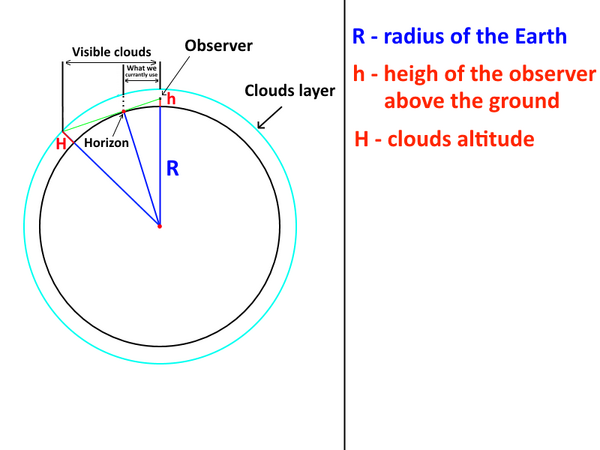- 6,108
- 963
I don't even know where to start with these formulas. Even instability is going to get a sizeable boost. So AGK is likely to go into outlier territory.
Follow along with the video below to see how to install our site as a web app on your home screen.
Note: This feature may not be available in some browsers.
Basicly the method remains the same as before. The only thing that is diffirient is that now we need to combine distance to the horizon from observer's PoV and distance to the horizon from clouds' altitude. (Its been decided to use volume of a cylinder just as before)DontTalkDT said:Been pretty busy lately. How are things going?
Have a few people checked the math behind the formula we are planning to use? (Has it been decided which formula to settle on?)
S = Sqrt((R+h)^2 - R^2) is the hormula to determine distance to the horizon. You can still use the old distance to the horizon calculator. Basicly you need to add distance to the horizon from observer height to distance to the horizon from clouds altitude.Mr. Bambu said:I do not understand it, that is true. I will point out that... you seem to have shifted the method in question.
In the OP, we have this: S = Sqrt((R+h)^2 - R^2)
Later, you use 14700+sqrt((6371000+460)^2-6371000^2)
So. What changed? 14700 was the given distance to the horizon, why in the world are we adding it to the equation for Distance to the Horizon? Just an example of a thing I do not understand about what is being discussed. I don't claim to be the brightest crayon in the box, don't get me wrong, which is why I generally assume those around me are more capable. But what changed between post one and post two?

Oh...swell that sucks. Was thinking it affected all storm calcsRicsi-viragosi said:Yes, this only affects horizon calced storms.
I don't really get the questionMr. Bambu said:I know. Why was "S =" substituted for "S +", was my main question.

We haven't decided yet. Either minimal 460 or avarage 2000.Therefir said:What is the cloud altitude we should use? 460 meters? Or the average of nimbostratus clouds?

Yes you did. Our distance is 164950 meter. So the speed is 164950/10 = 16495 m/sTherefir said:> Island level All Might is back
though I probably ****** up something...
Did All Might vs Escanor just become fairUgarik said:(685875725311100.32)*16495^2*0.5 = 9.3308252×10^22 J - 22.3 Teratons - Country level
I'm not a good calcer but I'm leaning towards this.Antvasima said:Given that Mr. Bambu considers this method ill-defined and hard to understand, and that it would likely lead to inflated results, I would prefer considerable evaluations and confirmations from DontTalkDT and the calc group members before we change our standards.
Storms will be 100% unusable in most cases. There are instances where this won't be the case, but often times this will cause them to be unusable. So. Prepare for that.Ricsi-viragosi said:Isn't it like, a massive outlier?
I get that he is the strongest guy around, but storms are so much inflatated with this that you might use energy to mass conversion for feats.